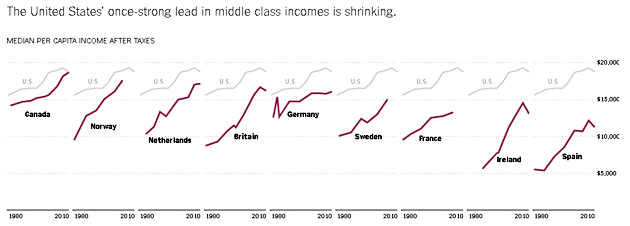
First, there was Wonkblog. Then came 538. Then Vox. And now we have The Upshot, a new venture from the New York Times that aims to present wonky subjects in more depth than you normally find them on the front page. Today, David Leonhardt and Kevin Quealy kick off the wonkiness with an interesting analysis of median income in several rich countries. Their aim is to estimate the gains of the middle class, and their conclusion is that America’s middle class is losing out.
Their basic chart is below. As you can see, in many countries the US showed a sizeable gap in 1990. Our middle class was much richer than most. By 2010, however, that gap had closed completely compared to Canada, and become much smaller in most other countries. Their middle classes are becoming more prosperous, but lately ours hasn’t been:

Germany and France show the same low-growth pattern for the middle class that we see in the United States, but countries like Norway, Ireland, the Netherlands, and Britain have shown much faster growth. What’s going on?
[The data] suggest that most American families are paying a steep price for high and rising income inequality. Although economic growth in the United States continues to be as strong as in many other countries, or stronger, a small percentage of American households is fully benefiting from it.
….The struggles of the poor in the United States are even starker than those of the middle class. A family at the 20th percentile of the income distribution in this country makes significantly less money than a similar family in Canada, Sweden, Norway, Finland or the Netherlands. Thirty-five years ago, the reverse was true.
Note that these figures are for after-tax income. Since middle-income taxes have been flat or a bit down in the United States, this isn’t likely to have had much effect on the numbers.















